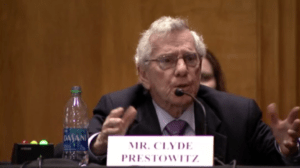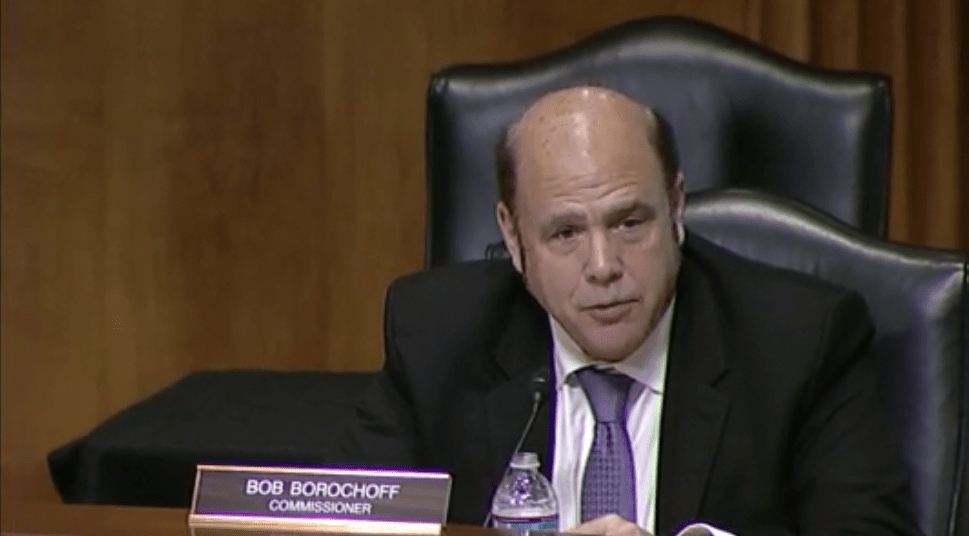Members of the U.S. China Economic and Security Review Commission got a crash course in market access charges on Thursday. An overvalued dollar was highlighted as one of the main reasons why tariffs have failed to reduce trade imbalances with China.
“The dollar tends to be chronically overvalued because it is the world’s major reserve currency. We have a trade deficit…but that is because there is only one product we make that everyone in the world wants and that is the dollar,” Clyde Prestowitz, Founder and President of the Economic Strategy Institute told the Commission as one of three panelists on Thursday to discuss ways the U.S. can challenge China’s practices.
“Other countries, China being one of them, manipulate their currencies. We do not have free currency markets. (These countries) set their currency to support their exports,” Prestowitz said. “We need to counter this activity. And one way to do it would be to impose a market access charge (MAC), so you put a three to four percent fee on incoming investment that is not greenfield (FDI) investment.”
Commissioner Bob Borochoff expressed the most interest in the MAC, asking Prestowitz, “How does a market access charge work…and what do you mean by it leveling the playing field?”
Prestowitz said that foreign investment in the dollar means more demand for dollars – be it U.S. securities like stocks, or Treasury debt and money market accounts kept to pay for dollar-denominated goods sold overseas. Strong demand makes for a stronger dollar and that makes U.S. exports more expensive and makes it cheaper for American companies to invest overseas as the dollar buys a lot more in Mexico and Vietnam than it does in New Mexico and Vermont.
“We know that many countries are managing their currencies – they don’t float freely as the U.S. does,” Prestowitz said about our biggest trade competitors around the world. “The way to counter that is to impose a charge on inflows of foreign capital. An objection to that would be, ‘yeah, but some of that capital might be to build a factory in the U.S.’ That’s why the idea is that FDI to produce is exempt from the MAC. But if you’re buying unproductive investment like real estate or it’s portfolio investment, then we can charge them and that charge can be flexible depending on our deficit, but let’s charge 3% to 4 % on inflows,” he told Borochoff, who runs The Borochoff Group, a company that operates primarily in the leisure dining space. His appointment on the Commission ends Dec. 31, 2023.
 Prestowitz explained to Borochoff that MAC fees could go into an infrastructure fund and make U.S. base production more effective while countering countries that manage their currency to the benefit of their exporters.
Prestowitz explained to Borochoff that MAC fees could go into an infrastructure fund and make U.S. base production more effective while countering countries that manage their currency to the benefit of their exporters.
“It’s not enough just to look at trade,” said Commissioner Jeffrey Fiedler. “We have to look at investment, too.”
China’s trade-distorting practices have only gotten worse since the trade war began in earnest under the Trump administration. No sector is immune, said Commissioner Michael Wessel in his opening remarks. “Last year’s $355 billion trade deficit with China included advanced technology products, with a gap of more than $113 billion, 11% higher than in 2020,” Wessel noted about how trade war tariffs did not really turn importers off to China. As much as they complained about higher prices, few left their mainland China factories.
The MAC, a small variable tax on incoming capital flows, would rise when U.S. trade deficits rise and fall when trade deficits fall. This would keep the inflow of foreign capital and upward pressure on the dollar‘s value consistent with a dollar exchange rate that is consistent with balanced trade.
In September 2020, CPA chief economist Jeff Ferry published a Working Paper examining the impact of a Market Access Charge on international capital inflows into the U.S. economy. CPA built a model including the relationships between U.S. capital flows, the dollar exchange rate, trade, and the domestic U.S. economy. The conclusion was that a 5% MAC would realign the dollar to a current account balancing exchange rate, balance trade and stimulate the economy, generating an additional $1 trillion of GDP, over 4 million additional jobs, and more than $300 billion of additional revenue for the U.S. Treasury.













